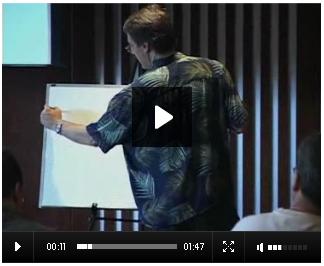Mel,
Back when I was in junior high I'd hop a bus downtown to visit all the stereo shops and soak up every scrap of knowledge I could.
I'm sure the sales people hated me.
I'd materialize once every month or so... monopolize an hour of their time... pummel them with questions about speakers, amplifiers, tape decks, turntables and decibels—then vanish without spending a single thin dime.
One of these patient souls once advised me, "You should read everything you can get your hands on."
I took that quite literally. Instead of clothes, most of the drawers in my dresser in my bedroom were stuffed with audio literature, brochures and catalogs.
Much later on, I discovered a dirty little secret:
95% of the products I was drooling over were COMMODITIES.
Vendors in the audio industry are among the very best, of any industry out there, at juking and jiving their way around the fact that the things they sell sound and perform *exactly* the same as their competitors.
One of the most brilliant of these dance moves was from Linn, a high-end audio manufacturer in Scotland.
Every stereo shop has a special room for the high end equipment.
And the top lines carried by that dealer compete fiercely for attention in that room.
One day someone at Linn figured out a sneaky way to nab the primo positioning in those rooms: "The Single Speaker Demonstration."
The shtick goes like this:
The existence of any other speaker in a room corrupts the sound and the listener experience.
Even a telephone, by its very presence, will distort the sound and make the listener's judgment suspect and unnatural.
Therefore only one speaker can be demonstrated at any one time; if you switch speakers, you must lug the old ones out of the room before new ones are brought in.
So they went out to all their dealers and showed this to them.
They would put a pair of speakers in the room and play them – then they'd bring a telephone in and out of the room.
Steve the Linn rep says, "Mark, can you hear the difference the presence of this little telephone makes?"
Mark thinks for a minute and says "Play that again, would you?"
So they do another trial. "Yeah, Steve, now I hear exactly what you're talking about. The midrange is muddier with the telephone in the room. Wow, that's amazing!"
The factory guy has successfully done a bit of psycho-manipulation on the dealer, who will in turn do this to many dozens of unsuspecting customers.
Next the factory guy pulls a sticker out of his notebook—it's a "Single Speaker Demonstration" sticker—and affixes it to the front door of the retail store.
Now this dealer is certified as a "Single Speaker Demonstration Room" dealer, and Linn's speakers are, of course, always the default speakers in this special room.
Linn then goes on to publish a list of dealers who conform to this now-higher standard of demonstrating audio equipment—and run ads promoting those dealers.
Fact check:
Does having another pair of speakers in the room change the sound?
Yes, it theoretically does.
However, the difference is microscopically small (especially compared to the rattling drywall, the air conditioner, and whatever else is going on).
Here's what's important though: It is now literally impossible for the customer to make a side-by-side comparison.
Your hearing is extremely susceptible to suggestion.
And the salesman, convinced by Linn's "single speaker" pitch, can now tell customers what he wants them to hear, instead of flipping a switch from A to B and letting them hear it for themselves.
Linn has deftly shoved the competition out of the way.
Now to be clear, what Linn did here isn't exactly ethical.
But the principle is one any business should heed:
The way to escape the "commodity trap" is to make it impossible for your customers to compare you 1-to-1 with anyone else.
An excellent way to do this is to create a "buyer's guide" for your market that lays out the questions customers should ask when choosing who to work with.
By encouraging your customers to ask questions that highlight your USP, you eliminate your competition without firing a shot.
Hey, nobody said this was going to be a fair fight!
Carpe Diem,
Perry Marshall
***NOTE: This email address isn't monitored! If you need help, please email:
support@perrymarshall.com
 | Free Video
We manage our emails with Infusion. This Guide and Video explain my secret marketing sauce. |